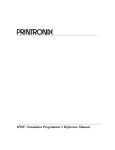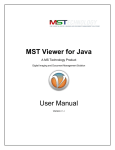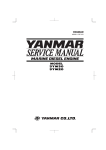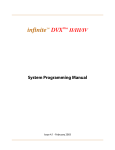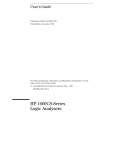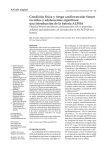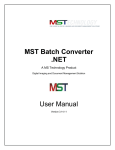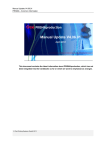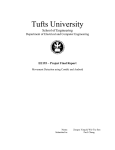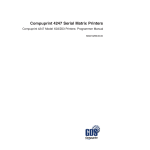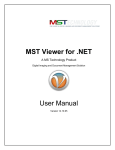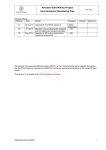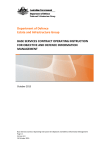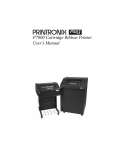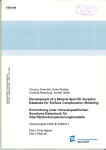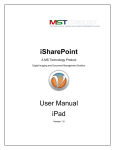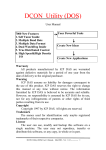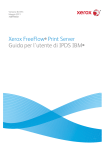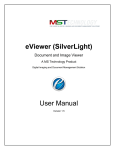Download IPDS™ Twinax Emulation Programmer`s Reference
Transcript
IPDS™ Twinax Emulation Programmer’s Reference Manual IPDS™ Twinax Emulation Programmer’s Reference Manual 164306-001, Rev. A Printronix, Inc. makes no representations or warranties of any kind regarding this material, including, but not limited to, implied warranties of merchantability and fitness for a particular purpose. Printronix, Inc. shall not be held responsible for errors contained herein or any omissions from this material or for any damages, whether direct, indirect, incidental or consequential, in connection with the furnishing, distribution, performance or use of this material. The information in this manual is subject to change without notice. This document contains proprietary information protected by copyright. No part of this document may be reproduced, copied, translated or incorporated in any other material in any form or by any means, whether manual, graphic, electronic, mechanical or otherwise, without the prior written consent of Printronix, Inc. COPYRIGHT 1998, PRINTRONIX, INC. All rights reserved. Trademark Acknowledgements IBM, AS/400, and SAA are registered trademarks, and IPDS, Intelligent Printer Data Stream, Bar Code Object Content Architecture and BCOCA are trademarks of International Business Machines Corporation. Printronix is a registered trademark of Printronix, Inc. Table of Contents 1 Introduction...........................................................7 About This Guide ................................................................................. 7 Sources of Additional Information ................................................. 7 Warnings and Special Information ................................................ 7 Compatible System Attachments......................................................... 8 Defining IPDS ...................................................................................... 8 The Protocol .................................................................................. 8 The Printer Environment ............................................................... 8 Emulations and Data Streams....................................................... 8 2 Configuring with IPDS Commands .......................9 Overview.............................................................................................. 9 The IPDS Emulation ............................................................................ 9 The Command Sets ...................................................................... 9 The Data Towers........................................................................... 10 The States ..................................................................................... 10 Processing a Page ........................................................................ 11 The Command Syntax .................................................................. 12 The Text Commands..................................................................... 13 Load Equivalence (LE) ........................................................... 13 Write Text (WT) ...................................................................... 13 Images .......................................................................................... 15 The IM Image Command Set ........................................................ 15 Write Image Control (WIC) ..................................................... 15 Write Image (WI)..................................................................... 15 Graphics ........................................................................................ 16 The Graphics Command Set......................................................... 17 Write Graphics Control (WGC) ............................................... 17 Write Graphics (WG) .............................................................. 17 Bar Codes ..................................................................................... 17 The Bar Code Command Set ........................................................ 18 Write Bar Code Control (WBCC) ............................................ 18 Write Bar Code (WBC) ........................................................... 18 The Page Segment Command Set ............................................... 18 Begin Page Segment (BPS) ................................................... 18 Delete Page Segment (DPS).................................................. 18 Table of Contents Include Page Segment (IPS) .................................................. 18 The Overlay Command Set........................................................... 19 Begin Overlay (BO)................................................................. 19 Delete Overlay (DO) ............................................................... 19 Include Overlay (IO)................................................................ 19 The Device Control Commands .................................................... 19 Begin Page (BP) ..................................................................... 19 End ......................................................................................... 19 End Page (EP)........................................................................ 20 Load Copy Control (LCC) ....................................................... 20 Load Font Equivalence (LFE) ................................................. 20 Load Page Descriptor (LPD)................................................... 20 Load Page Position (LPP) ...................................................... 20 No Operation (NOP) ............................................................... 20 Sense Type and Model (STM)................................................ 20 Set Home State (SHS)............................................................ 21 Execute Order Anystate (XOA)............................................... 21 Execute Order Home State (XOH) ......................................... 22 Exception Processing and IDs ...................................................... 22 A Glossary .............................................................. 31 1 Introduction About This Guide This manual contains the IPDS configuration menu, lists the command sets and provides error messages. This manual assumes you are familiar with IPDS and programming in IPDS. This book is not a tutorial-it does not explain how to program nor does it describe which applications support which commands. For detailed information, refer to the list below. Sources of Additional Information • IBM Intelligent Printer Data Stream Reference • • IBM System/36 Concepts and Programmer's Guide • • • • • Forms Design Reference Guide for Printers • Guide to Programming for Printing, Version 2 IBM System/38 Guide to Program Product Installation and Device Configuration IBM 9370 Information System: Customizing the Work Station Subsystem IBM 9370 Information System: Work Station Subsystem and Reference IBM AS/400 Programming: Data Management Guide 4234 Printer Models 007, 008, 011, and 012 Product and Programming Description Warnings and Special Information For your safety and to protect valuable equipment, it is very important that you read and comply with all information highlighted under special headings: WARNING CAUTION IMPORTANT Conditions that could harm you as well as damage the equipment. Conditions that could damage the printer or related equipment. Information vital to proper operation of the printer. NOTE: Information and helpful tips about printer operation. 7 Chapter 1 Compatible System Attachments Compatible System Attachments With a twinax interface, you can attach your IPDS-compatible printer to the following systems: • • • • System/36 (SSP 5.1 plus IPDS PRPQ P84094) System/38 (with Rel. 8 System/38 Control Program Facility) AS/400 processor 5294/5394/5494 control units (The coax IPDS emulation is currently not used.) IPDS characteristics available on each of the above attachments are not completely uniform, but the emulation printers are as fully functional on these attachment as provided by the host vendor. Defining IPDS IPDS is both a protocol and a printer mode. The two terms do not mean the same thing. The Protocol A protocol is a set of rules governing the exchange of information between the printer and the host computer. The rules are codes that manipulate and print data and allow for machine-to-machine communication. A printer and the host computer must use the same protocol. IPDS is the protocol for your printer. Refer to your IBM documentation for details about commands, etc. The printer uses EBCDIC character codes to print text, numbers, and punctuation. Some EBCDIC characters, singly and in groups, are used as control codes. Control codes instruct the printer to perform specific functions. The Printer Environment The printer operates under “IPDS” (text and graphics) mode. In the IPDS mode, the data stream has special sequences to denote IPDS commands. Emulations and Data Streams Your IPDS printer emulates only IBM 4234 twinax models 008 and 012. Twinax printers always use IPDS data streams for sending commands. Even a simple job, such as a screen print, is IPDS data in a twinax attachment. Because the printer definition on a twinax host is either set automatically (by auto configuration) or manually, the printer type is already known. NOTE: Sending a non-IPDS data stream to an IPDS printer and vise versa will result in a hung spool file or writer. 8 2 Configuring with IPDS Commands Overview This chapter summarizes IPDS, lists control codes, and lists error messages. For detailed information, refer to “Sources of Additional Information” on page 7. The IPDS Emulation IPDS consists of the following command sets, which are defined in more detail beginning on page 13. The Command Sets Text This set contains the commands used to present text information on a page, on a page segment, or on an overlay. IM Image The commands for this functional area output raster image data on a page, a page segment, or on an overlay. IO Image Not available for impact IPDS printers. Graphics To present vector graphics on a page, a page segment or on an overlay, use the commands in this set. Bar Code This set contains the commands and data controls needed to produce bar codes. Page Segment The commands used to store and present page segments that contain text, graphics, image, and bar code information. Overlay The commands used to store and present overlays that contain text, graphics, image, and bar code information. Device Control This set contains commands that let you set up a page and manage printer-host communication. 9 Chapter 2 The IPDS Emulation The Data Towers Most of the IPDS commands contain data fields. The type of data is categorized into the following data towers: Text The Presentation Text Object Content Architecture (PTOCA) commands are a part of the text data tower. This information is necessary to print text in a page, a page segment, or an overlay. IM Image The image data enables the printer to print images in a page, a page segment, or an overlay. IO Image This is not supported. Graphics The Graphic Object Content Architecture (GOCA) commands are a part of the graphics data tower. This information is necessary to print images in a page, a page segment, or an overlay. Bar Code The Bar Code Object Content Architecture (BCOCA) commands are a part of the bar code data tower. This information is necessary to print bar codes in a page, a page segment, or an overlay. Some of the data towers contain only one level of commands; some contain two. PTOCA, GOCA, and BCOCA are described in more detail in your IBM documentation. The States IPDS-capable printers are known as “state machines.” As the printer recognizes a specific command, it operates in the state identified with that command. Figure 1 shows the transition of the different states. Home State The initial operating state. The printer returns to this state after a page, an overlay, or a page segment has been sent. Block States The printer establishes the processing conditions for a data block to be accepted. There are three block states: IM image, graphics, and bar code. Page State While printing a logical page, the printer is in the Page State. Overlay State This state permits overlay data blocks to be stored. An overlay is a block of data that is frequently accessed. It can be a block of text, images, graphics, or bar codes. An overlay can be a predefined page or part of a page and is often used for forms. Page Segment State Page segment data is stored when the printer is in this state. A page segment is a frequently accessed resource; it can be a block of text, images, graphics, or bar codes. Page segments can be a part of an overlay. Anystate 10 Some commands can be received in any state. Processing a Page Begin Page Page State Block State End Page State End Page Home State Home State Begin Page Segment Page Segment State Begin Overlay Overlay State Block State End Page Segment State Block State End Overlay State End Page End Page Figure 1. State Transition Processing a Page Your printer can print page by page or it can behave as a line printer. This section describes how the printer prints page by page. (The User's Manual explains the two printing methods in more detail.) Your IPDS-capable printer builds a page by gathering all the page descriptor commands and data blocks that are specified in the data stream. Page descriptor commands instruct the printer to create and position a logical page, which rests within the perimeter of the physical page. 11 Chapter 2 The IPDS Emulation Overlay Physical Page (Medium Presentation Space) Block Logical Page Page Segment Figure 2. Processing a Page Blocks contain images, graphics, bar codes, coded fonts, and text. Each block is recognized by specific, functional commands. To print a bar code, for example, Bar Code commands must be in the data stream. As each type of data block is stored in memory, the printer moves from state to state. For example, when the printer is reading the Bar Code commands, it is in the bar code state. Once all the data has been stored, the page can be closed with an End Page command and the printer, which is now in the Home State, is ready to print the page. The Command Syntax The commands on the following pages use this syntax: Byte Count D6XX Flag CID Data Byte Count A two-byte field. Specifies the length of the command. 12 D6XX A two-byte field. “D6” denotes an IPDS command; “XX” is the hex code for the IPDS command. Flag A one-byte field containing the IPDS command stream flags. You can request an Acknowledgement Required response from the printer in this field. CID Correlation ID. A two-byte field that identifies the command. If an exception (error) occurs, the printer will respond with a Negative Acknowledge Reply and the CID associated with the command. Data 0-32760 bytes if CID is present; 0-32762 bytes if CID is not present. This field contains parameters, orders, and data necessary for implementing the command. The Text Commands The Text Commands The following commands are used to present text blocks in a page, a page segment, or an overlay. Load Equivalence (LE) Byte Count D61D Flag CID Data This command allows the printer to use a single suppression ID for more than one suppression pair. Write Text (WT) Byte Count D62D Flag CID Presentation Text Object; Content Architecture control codes and character data Use this command to send character data and controls to the printer. The data and controls can begin in one Write Text command chain and end in another Write Text command chain. Controls are listed on the following pages. The first control is preceded by the escape sequence 2B D3. Subsequent controls will follow as long as the preceding code is a chained code. 13 Chapter 2 The IPDS Emulation Table 1. Control Codes Control Sequence Unchained Hex Code Chained Hex Code Absolute Move Baseline (AMB) D2 D3 Absolute Move Inline (AMI) C6 C7 Begin Line (BLN) D8 D9 Begin Suppression (BSU) F2 F3 Draw B-Axis Rule (DBR) E6 E7 Draw I-Axis Rule (DIR) E4 E5 End Suppression (ESU) F4 F5 No Operation (NOP) F8 F9 Overstrike (OVS) 72 73 Relative Move Baseline (RMB) D4 D5 Relative Move Inline (RMI) C8 C9 Repeat String (RPS) EE EF Set Baseline Increment (SBI) D0 D1 Set Coded Font Local (SCFL) F0 F1 Set Inline Margin (SIM) C0 C1 Set Intercharacter Adjustment (SIA) C2 C3 Set Text Color (STC) 74 75 Set Text Orientation (STO) F6 F7 Set Variable Space Character Increment (SVI) C4 C5 Temporary Baseline Move (TBM) 78 79 Transport Data (TRN) DA DB Underscore (USC) 76 77 Absolute Move Inline (AMI) C6 C7 Begin Line (BLN) D8 D9 Begin Suppression (BSU) F2 F3 Draw B-Axis Rule (DBR) E6 E7 Draw I-Axis Rule (DIR) E4 E5 End Suppression (ESU) F4 F5 14 Images Images The physical page is the actual medium used, such as a continuous form or an 8 1/2 x 11 inch sheet of paper. The logical page is mapped onto the physical page; you can set its size and position inside the physical page. The logical page contains the image blocks, text blocks, segment and overlay blocks. A block is an area where the image is mapped to. The image presentation space contains the image that will be mapped to the block. The image presentation space contains the entire image. An image block can be the same size, larger or smaller than the image presentation space. Image Physical Page Logical Page Image Presentation Space which is mapped into the Image Block Figure 3. Generating Images The IM Image Command Set The following commands are used to present image data (raster format) in a page, a page segment, or an overlay. Write Image Control (WIC) Byte Count D63D Flag CID Data This command defines the following: the image presentation space size and resolution, the image block size, position and orientation on the logical page, and the mapping of the image presentation space into the image block. You can specify that the image presentation space fits into the image block or you can crop a portion of the presentation space and map that to the image block. Write Image (WI) Byte Count D64D Flag CID Data This command is used to denote image data to be printed. 15 Chapter 2 The IPDS Emulation Graphics Graphics contain line drawings, such as arcs and lines. The area containing the entire drawing is called the graphics presentation space. Usually, only a part of the drawing will be printed. This part is referred to as the graphics presentation space window. Graphics Presentation Space Image Physical Page Logical Page Graphics Presentation Space Window which is mapped into the Graphics Block Figure 4. Generating Graphics In order to place the graphics presentation space window onto a logical page, it must be mapped to a graphics block on the logical page. This block can be the same size, larger, or smaller than the graphics presentation space. When you map the window to the graphics block, you have three methods to choose from: 16 • Scale to fit mapping - The window will be the same size as the graphics block. • Center and trim mapping - The window is centered inside the graphics block. • Position and trim mapping - The window's top left corner is mapped to the graphics block and is affected by the graphics block's offset parameters. The Graphics Command Set The Graphics Command Set The following commands are used to present graphics in a page, a page segment, or an overlay. Write Graphics Control (WGC) Byte Count D684 Flag CID Graphics Area Position; Graphics Output Control; Graphics Data Descriptor WGC specifies the graphics block position, size and orientation; it specifies the graphics presentation space window size and location inside the graphics presentation space; and it defines how the window will map into the graphics block. Write Graphics (WG) Byte Count D685 Flag CID Begin Segment Introducer and drawing orders The WG command follows the Write Graphics Control command and contains information about the graphics presentation space. This data is referred to as drawing orders. Bar Codes Bar codes contain information that can be read by optical scanners and are widely used. A bar code resides in a bar code presentation space, which is mapped to a bar code block that exists on the logical page. This block can be the same size, larger, or smaller than the bar code presentation space. The entire bar code presentation space must be mapped to the bar code block; you cannot trim and cut any of the bar code presentation space. 17 Chapter 2 The IPDS Emulation The Bar Code Command Set The following commands are used to present bar codes in a page, a page segment, or an overlay. Write Bar Code Control (WBCC) Byte Count D680 Flag CID Bar Code Area Position; Bar Code Output Control; Bar Code Data Descriptor Use this command to set the bar code block position, size, and orientation; to set the bar code presentation size; the bar code to be used; and to set how the bar code presentation space will map into the bar code block. Write Bar Code (WBC) Byte Count D681 Flag CID Data This command sends Bar Code Object Content Architecture data to the printer and applies to only one bar code symbol. To print another bar code symbol, you must send another WBC command. The Page Segment Command Set The following commands are used to access printer data by name and merge on the logical page. Begin Page Segment (BPS) Byte Count D65F Flag CID Data This command identifies the data following as data for a page segment. Delete Page Segment (DPS) Byte Count D66F Flag CID Data DPS instructs the printer to delete one or all of the stored page segments. Include Page Segment (IPS) Byte Count D67F Flag CID Data When you issue an IPS command, a stored page segment can be processed as if the printer had just received it. 18 The Overlay Command Set The Overlay Command Set Overlays contain data that is frequently accessed and can be stored by name for future use. You can create an overlay so that it fills the entire page or fills part of a page. The following overlay commands are used to access printer data by name and merge on the logical page. Begin Overlay (BO) Byte Count D6DF Flag CID Data This command tells the printer to store the following parameters (including Logical Page Descriptor, Load Font Equivalence, and Load Equivalence) for an overlay and not to print immediately. Delete Overlay (DO) Byte Count D6EF Flag CID Data The Delete Overlay command instructs the host to delete one or all of the stored overlays. The host can reuse the deleted overlay identification numbers for new overlays. Include Overlay (IO) Byte Count D67D Flag CID Data Issue an Include Overlay command to place an overlay on a logical page. The Device Control Commands The following commands are used to set up the page format, to communicate control commands, and to oversee the acknowledge reply. Begin Page (BP) Byte Count D6AF Flag CID Data This command indicates the beginning of a page and causes the printer to enter the page state. End Byte Count D65D Flag CID Binary Data This command notes the end of a block containing: an image, graphics, or bar codes. 19 Chapter 2 The IPDS Emulation End Page (EP) Byte Count D6BF Flag CID Binary Data This command notes the end of a page, a page segment, or an overlay and returns the printer to the home state. Load Copy Control (LCC) Byte Count D69F Flag CID Data This command is effective only in the home state and controls the number of times you want to print the current logical page. Load Font Equivalence (LFE) Byte Count D63F Flag CID Data This command is used to re-identify local font data IDs to host specified font resource IDs. Load Page Descriptor (LPD) Byte Count D6CF Flag CID Data The LPD command sets the logical page's characteristics, such as the units for positioning text, the margins, and line spacing, etc. Load Page Position (LPP) Byte Count D66D Flag CID Data The LPP command sets the position of the logical page on the physical page, which allows for any required offsetting. No Operation (NOP) Byte Count D603 Flag CID Data This command tells the printer to perform no operation. Sense Type and Model (STM) Byte Count D6E4 Flag CID This command asks the printer to identify its capabilities. The printer responds with one or more Acknowledge Replies, which contain general information and command set vectors that identify supported IPDS function sets and subsets. 20 The Device Control Commands Set Home State (SHS) Byte Count D697 Flag CID Data SHS instructs the printer to return to the home state. If the printer is in the process of printing (in page state), the current page ends and prints the data up to the time of the SHS command. Depending when the SHS command was sent, either a complete or partially completed page prints. If the printer is processing a page segment, an overlay, or a font, the printer deletes the block of data and returns to the home state. If you send an SHS command while the printer is in the home state, the printer treats it as an NOP command. Execute Order Anystate (XOA) Byte Count D633 Flag CID Data (Code and Parameters) The XOA command is used to identify an order that is effective immediately, no matter what state the printer is in. You can specify only one order for each XOA command. Valid orders are listed in Table 2. Table 2. Execute Order Anystate Commands Order Function Hex Code Discard buffered data Deletes all data in the buffer, including the current job. F200 Exception Handling Control Exception Handling Control, which enables the host to control how the printer reports and processes exceptions. F600 Print Quality Control Specifies the print quality: AB - FE = NLQ 56 - AA = DP 01 - 55 = Draft FF = Printer Default F800 Request Resource List The host inquires about the printer’s current resources (page segments, overlays, fonts). F400 21 Chapter 2 The IPDS Emulation Execute Order Home State (XOH) Byte Count D68F Flag CID Data (Code and Parameters) The following orders are valid only when the printer receives them in the home state. The XOH command identifies these orders. Table 3. Execute Order Home State Commands Order Function Hex Code Erase Residual Print Data Prevents access to resident print data. 0500 Obtain Printer Characteristics Used for Acknowledge Replies. F300 Print Buffered Data All data in the buffer prints. 0100 Set Media Size Specifies the page size. 1700 Exception Processing and IDs Unlike some other protocols, IPDS allows the host to control exception (error) processing, which can free up the printer cpu. The host can request one of two methods: • • the printer must print the pages as requested the printer does not allow any page that has a data stream error to print The first method applies for situations such as printing checks; the second method applies for printing drafts or when troubleshooting the data streams. The following tables list the exception IDs and the error conditions. The exception ID consists of three parts. For example: 8001..00 80 = sense byte 0, which indicates a command reject 00 = sense byte 1 00 = sense byte 2 Table 4. Exceptions: Rejected Comands Exception ID 22 Condition 800100 Invalid IPDS command code 800200 Invalid IPDS command sequence 80E000 Invalid IPDS command length Exception Processing and IDs Table 5. Exceptions: Data Check Exception ID Condition 082100 Undefined character 086000 Numeric representation precision check 08C100 Position check Table 6. Exceptions: Specification Check - Bar Code Exception ID Condition 040000 Symbol Reference point outside Logical page 040200 Attempt to print Barcode or HRI character out of presentation space 040300 Invalid or unsupported bar code type 040400 Unsupported font local ID or font not available 040500 Invalid or unsupported bar code color 040600 Invalid or unsupported module width 040700 Invalid or unsupported element height 040800 Invalid or unsupported height multiplier 040900 Invalid or unsupported wide-to-narrow ratio 040A00 Invalid or unsupported symbol origin 040B00 Invalid or unsupported bar code modifier 040C00 Invalid or unsupported bar code data length 040E00 Check-digit calculation 041000 Invalid or unsupported human-readable interpretation location 041100 Attempt to print portion of symbol outside block or VPA 23 Chapter 2 The IPDS Emulation Table 7. Exceptions: Specification Check - Graphics Data Exception ID Condition 030001 Unallocated or unsupported graphics order or command code 030002 Reserved byte exception or invalid attribute set 030003 Incorrect drawing order length 030004 Invalid attribute value 030008 Truncated order 03000C Segment prolog 03000E Unsupported attribute value 030021 Invalid or unsupported default 033400 Character angle value not supported 033E00 Invalid End Prolog 036000 Area bracket 036800 Begin Area received incorrectly 036801 Area truncated 036802 Supported order invalid in area 036803 Pattern Set not supported 036804 Undefined pattern symbol 037001 Unsupported Begin Segment introducer segment flag 037082 Invalid Begin Segment introducer segment flag 0370C1 Invalid Begin Segment introducer length 0370C5 Insufficient segment data 039200 Graphics image order sequence 039201 Image data discrepancy 039300 Graphics image bracket 039301 Incorrect number of Image Data drawing orders 03C200 Marker Set not supported 03C201 Undefined marker code 03C202 Mismatched marker set 03C300 Font not available 24 Exception Processing and IDs Table 7. Exceptions: Specification Check - Graphics Data (continued) Exception ID Condition 03C301 Undefined graphics character code 03C302 Mismatched character set 03C601 Arc drawing check 03D100 Truncated graphics image 03D101 Invalid order in graphics image 03D102 Graphics image format not supported 03D103 Image width greater than maximum supported 03D104 Image height greater than maximum supported 03E100 Relative line outside coordinate space Table 8. Exceptions: Specification Check - General Exception ID Condition 020003 Character exceeds presentation text object space 020001 Embedded control sequence code 020201 End Suppression (ESU) control-sequence 020202 Invalid or unsupported IPDS command length 020205 Invalid data self-defining-field length 020302 IPDS command header length too small 020305 Invalid or unsupported block orientation 020401 EP command encountered 020402 Invalid use of Acknowledgement-Continuation Bit 020405 Invalid or unsupported value for area-position reference system 020501 Invalid spanning sequence 020505 Invalid or unsupported self-defining-field unit base 020601 Invalid Begin Suppression (BSU) 020605 Invalid or unsupported units per unit base 020705 Invalid or unsupported self-defining-field extents 020805 Invalid or unsupported mapping option 25 Chapter 2 The IPDS Emulation Table 8. Exceptions: Specification Check - General (continued) Exception ID Condition 020905 Invalid or unsupported axis offsets 020A05 Data within a block might be outside the VP Data within a block might be outside the VP (asynchronously detected) 020B05 Invalid self-defining-field identifier 020F01 Invalid or unsupported Set Text Orientation (STO) 021001 Invalid or unsupported Set Inline Margin (SIM) 021101 Invalid or unsupported Set Baseline Increment (SBI) 021201 Invalid or unsupported Intercharacter adjustment 021301 Invalid or unsupported Absolute Move Baseline (AMB) 021401 Invalid or unsupported Absolute Move Inline (AMI) 021402 The font, font section, or font index to be deleted is not found 020502 Unsupported baseline move 021501 Invalid or unsupported Relative Move Inline (RMI) 021502 Invalid or unsupported DF command font or font-section ID 021601 Invalid or unsupported Relative Move Baseline (RMB) 021701 Invalid or unsupported Set Variable-Space Increment (SVI) 021702 Invalid or unsupported value for DF command deletion type 021802 Invalid, unsupported, or unavailable font ID 021901 Invalid or unsupported value for Repeat String (RPS) repeat length 021902 Multiple occurrences of the same LFE font-equivalence number 021C01 Invalid escape sequence 021D02 Invalid or unsupported value for the Load Font Equivalence GRID 021E01 Invalid WT control-sequence length 021E02 Mismatch between font and the XOA Print Quality Control (PQC) command 021F01 Repeat String (RPS) length 021F02 Mismatch of LFE command font Host-Assigned IDs 022E02 Insufficient font data received 023001 Insufficient storage for LCC copy-control record 023101 Invalid or unsupported value for Load Copy Control number of copies 023201 Invalid or unsupported Load Copy Control Keyword in copy-group entry 26 Exception Processing and IDs Table 8. Exceptions: Specification Check - General (continued) Exception ID Condition 023401 Invalid or unsupported value for Load Copy Control entry-byte count 023601 Invalid or unsupported Load Copy Control simplex/duplex parameter 023801 Maximum supported number of overlays per LCC copy group exceeded 023901 Maximum supported number of suppression per LCC copy group exceeded 023F02 STO-SCFL-LFE mismatch 024201 WIC Pel count is less than the minimum required 024301 WIC command pel count is greater than the maximum supported value 024401 WIC command scan count is less than the minimum required 024501 WIC command scan count is greater than the maximum supported value 024601 Invalid WIC source image format 024701 Invalid or unsupported value for Write Image Control magnification factor 024702 Invalid or unsupported value for Load Font Equivalence font-inline sequence 024801 Invalid or unsupported value for Write Image Control scan-line direction 024901 Invalid scan-line-sequence direction in a WIC command 024A01 Invalid or unsupported value for Write Image Control image block location 025301 Invalid or unsupported value for Write Image Control image color 025803 Invalid or unsupported value for test color 025C02 Invalid or unsupported parameter in a DUA command 026002 Invalid or unsupported value for Logical Page Descriptor units per unit base (Xp and l) 026102 Invalid or unsupported value for Logical Page Descriptor units per unit base (Yp and B) 026202 Invalid or unsupported value for LPD Xp extent or XOH-SMS Xm extent 026302 Invalid or unsupported value for LPD Yp extent or XOH-SMS Ym extent 026401 Insufficient control storage 026402 Invalid or unsupported value for Logical Page Descriptor unit base 026802 Invalid or unsupported value for Logical Page Descriptor inline-sequence direction 026902 Invalid baseline-sequence direction in the LPD command 026A01 Insufficient source image data 27 Chapter 2 The IPDS Emulation Table 8. Exceptions: Specification Check - General (continued) Exception ID Condition 026A02 Invalid or unsupported value for Logical Page Descriptor initial 1 print coordinate 026B01 Excess source image data received 026B02 Invalid or unsupported value for Logical Page Descriptor initial B print coordinate 027002 Invalid or unsupported value for XOH Set Media Size units per unit base 027202 Invalid or unsupported value for XOH Set Media Size Xm extent 027302 Invalid or unsupported value for XOH Set Media Size Ym extent 027402 Invalid or unsupported value for XOH Set Media Size unit base 028101 Insufficient storage for a page segment or overlay 028501 Invalid or unsupported value for Delete Overlay command overlay ID 028A01 Invalid or unsupported value for Delete Page Segment command page segment Host-Assigned ID 029001 Invalid or unsupported overlay ID 029101 BO overlay ID already loaded 029102 Invalid or unsupported value for XOA Request Resource List entry 029201 Overlay ID not loaded 029202 Invalid XOA Print-Quality Control (PQC) parameter 029301 Recursive overlay invocation 029401 Invalid or unsupported value for page segment Host-Assigned ID 029501 Page segment Host-Assigned ID already loaded 029601 Page segment Host-Assigned ID not loaded 029701 Overlay nesting limit exceeded 029801 Invalid or unsupported suppression number 029803 Invalid or unsupported value for Temporary Baseline Move control sequence 02A401 Page boundary in the X-direction cannot be represented in the printer 02A501 Page boundary in the Y-direction cannot be represented in the printer 02AC01 Insufficient main storage to print the sheet 02AD01 Invalid or unsupported value for Logical Page Position command 02AE01 Invalid or unsupported parameter in an IO command 28 Exception Processing and IDs Table 8. Exceptions: Specification Check - General (continued) Exception ID Condition 02AF01 Insufficient storage to print the sheet (Asynchronously detected insufficient storage to print the sheet) 02C101 Maximum number of simplex or duplex keywords in an LCC command 02C102 Internal value not unique in an LE command 02C602 Invalid mapping type in an LE command 02C801 An unsupported input Media Source ID was specified 02C802 Invalid or unsupported internal value or external value in an Load Equivalence command 02FF02 Exceptions detected but not queued 29 Chapter 30 2 The IPDS Emulation A Glossary Acknowledge Reply A message about printer information or exceptions that the printer sends to the host. It can be a positive or negative reply. ([N]ACK can contain status resource or counter information.) bar code A printed code consisting of parallel bars of varied width and spacing and designed to be read by a onedimensional scanning device. bar code block It is a rectangular space that has a specified size, position, and orientation on a logical page. It is the area into which the bar code presentation space is mapped. bar code presentation space It is a rectangular, conceptual space where a bar code is generated. The entire bar code presentation space must be mapped to the bar code block. bold A print attribute specifying text of a heavy line thickness. See also character weight. buffer A reserved area in memory that data is written to and read from during data transfers. character set A protocol instructing the printer how to construct a set of printable characters, including symbols, punctuation, numbers, diacritical markings, and alphabet characters. Each character is assigned a unique address in memory. character weight The degree of lightness and thickness of printed text. For example: “Bold” refers to a heavy or thick character weight. “Medium,” “normal,” or “book weight” refer to the character weight used in this sentence. control sequence A series of bytes that instruct the printer to perform a specific function. correlation ID (CID) Identifies a specific command/data transmission from the host. This two-byte value is used to match any exceptions (errors or conditions specified in an Acknowledge Reply) with the IPDS command. cpi Abbrev. for characters per inch. A measurement of monospaced fonts indicating the horizontal character density. For example, 10 cpi means 10 characters can be printed in one horizontal inch. default A value, parameter, attribute, or option assigned by a program or system if another is not specified by the user. 31 Appendix A deferred printing The printer prints page by page: It gathers all of the page descriptor commands and data blocks for each page and then prints the page. diagnostic Pertains to the detection and isolation of printer malfunctions or mistakes. emulation Refers to the ability of a printer to execute the commands of another printer language (protocol). environment The parameters that affect how data will display on a page, such as the dimensions, orientation, and location of the logical page on the physical page. An overlay has its own environment; a page segment is affected by the environment that is placed into. expanded A font enhancement referring to larger-than-normal character width with no change in character height. exception A condition in which the printer notifies the host and will sometimes require the host to resend data. An exception can also be in response to an invalid data stream. family (or type) A set of all variations and sizes of a type style. fixed-pitch fonts See font. FOCA Abbrev for Font Object Content Architecture. A collection of methods and rules for describing fonts. font Referred to as a resource that is stored in memory. The complete set of a given size of type, including characters, symbols, figures, punctuation marks, ligatures, signs, and accents. To fully describe a font, you must specify seven characteristics: 1) typeface 2) spacing (proportional or monospaced) 3) type size (12 point, 14 point, etc.) 4) scale factor (character height/width ratio) 5) type style 6) character weight 7) character proportion (normal, condensed, expanded). GOCA Abbrev for Graphic Object Content Architecture. A collection of methods and rules for describing graphic data. graphics Lines, arcs, etc. used to draw a picture. Differs from an image. graphics block Rectangular space that has a specified size, position, and orientation on a logical page. It is the area where the graphics presentation space (or the graphics presentation space window) is mapped to. graphics presentation space Rectangular, conceptual space where graphics are generated. graphics presentation space window You can specify a part of the presentation space to be 32 mapped to the graphics block. This portion is called the graphics presentation space window. Specifying a window is synonymous to cropping or trimming. home state The initial state of the printer before it begins downloading overlays, page segments, and/or fonts. After the printer prints the page, the printer returns to the home state. host assigned ID The host assigns an ID to every resource (page segment, overlay, or font). These IDs are used for loading and calling. host computer The computer that stores, processes, and sends data to be printed, and which communicates directly with the printer. The term “host” indicates the controlling computer, since modern printers are themselves microprocessor-controlled computer systems. image An illustration or picture. Differs from graphics. image block Rectangular space that has a specified size, position, and orientation on a logical page. The image block contains the image. It is the area where the image presentation space is mapped to. image presentation space Rectangular, conceptual space where an image is generated. It is mapped to the image block. Once mapped, the image is ready to be printed. initialization A series of processes and self-tests to set power-up default conditions and parameters. interface The hardware components used to link two devices by common physical interconnection, signal, and functional characteristics. invoke To put into effect or operation. IPDS Intelligent Printer Data Stream. Allows sophisticated printing, such as merging text and graphics. lpi Abbrev. for lines per inch. A measurement indicating the vertical spacing between successive lines of text. For example, 8 lpi means 8 lines of text for every vertical inch. logical page A rectangular area on a physical page. The logical page has a specified size, orientation, location, and offset. The logical page is the area where bar code blocks, image blocks, graphics blocks, and text is printed. Printing occurs in the area common to the physical page and the logical page. logical link The parameters that specify data transfer, control, or communication operations. no operation This command causes the printer not to process anything, but instead, to proceed to the next command sequence. 33 Appendix A object Another term for a font, graphics, image, text, or a combination of these. offset An offset is a measurement indicating displacement. For example, you can specify the logical page to rest in the lower left hand corner of the physical page. ordered printing The printer behaves like a line printer: It begins printing as soon as you send the data. orientation The degrees of rotation of a presentation space or a data block. overlay This is usually a form. It can contain text, graphics, an image, and bar code data. You can also merge a page segment into an overlay. The overlay can encompass the entire logical page or a portion of it. The overlay has its own environment, unlike a page segment. overlay ID The host assigns an ID to every overlay so that it can be identified for particular commands, such as Begin Overlay, Delete Overlay, Include Overlay, etc. overlay state This state permits overlay data to be downloaded and produced. page See logical page and physical page. page segment Contains a font, image, text, or graphics and is merged onto a logical page. A page segment has an ID and can be stored for future use. It does not have its own environment; instead, it uses the environment that it is merged into. You can load a page segment into an overlay. page segment state This state allows page data to be loaded and produced. 34 parity (check) Parity checking is the addition of non-data bits to data, resulting in the number of 1 bits being either always even or always odd. Parity is used to detect transmission errors. Parity represents the value in the check digit of the received or transmitted data. physical page The medium that the printer prints data on. pixel Derived from picture element. The smallest displayable picture element on a video monitor or printable unit. In printing, a pixel is a dot. point A unit of length in printing and typography, used to specify type sizes, heights of font characters, etc. There are 72 points in a vertical inch; thus, one point equals 1/ 72 inch, or approximately 0.0138 inch. Some examples of point sizes are: This is 8 point type. This manual is printed in 10 point type. This is 14 point type. port A channel used for receiving data from or transmitting data to one or more external devices. presentation space A space where data can be generated before it is mapped onto the logical page. The presentation space uses an X-axis and Y-axis to specify addresses. protocol A set of rules or conventions governing the exchange of information between computer systems. For computer printers, a protocol is the coding convention used to convey and print data. A printer protocol includes character codes, printer function codes, and machine-tomachine communication codes. RAM Acronym for random-access memory. Also called “main memory” or “working memory.” RAM is the active memory of a printer, into which programs are loaded. This memory can be read from or written to at any timehence the term “random-access.” RAM is also termed “volatile” because whatever is in RAM is lost when power is turned off or interrupted. read To retrieve data from memory (RAM, NVRAM) or mass storage (hard disk, floppy diskette, etc.). reset To turn off, deactivate, disable, or return to a previously determined state. resolution A measure expressing the number of units in a given range used to create an image. In printing, this is expressed as the number of dots per inch (dpi) horizontally and vertically. ROM Acronym for read-only memory. Programs, instructions, and routines permanently stored in the printer. ROM is not lost when power is turned off and cannot be written to, hence the term “read-only.” ROM-resident fonts are fonts permanently stored in a printer and available at any time. set To turn on, activate, invoke, or enable. string Two or more bytes of data or code treated as a unit. twinax Twinaxial. A type of cable with two wires surrounded by insulation and a braided shield. type style Refers to either the upright or italic character style in a specific font family. Roman is upright, italic is slanted. typeface A descriptive name or brand name that identifies a particular design of type. Also called type family. weight See character weight. write To place data in memory (RAM, NVRAM). 35 Appendix A 36 Index A Device control commands, 9, 19 Acknowledge reply, managing, 19 E Anystate, 10 B Emulation, 8 End command, 19 Bar codes, 17 End Page command, 20 command set, 9 Environment, IPDS, 8 commands, 9, 18 Error codes, 22 data tower, 10 Exceptions, 22 errors, 23 data check, 23 Begin Overlay command, 19 rejected commands, 22 Begin Page command, 19 specification check - bar code, 23 Begin Page Segment command, 18 specification check - general, 25 Block state, 10 specification check - graphics data, 24 C Center and trim mapping Execute Order Anystate command, 21 Execute Order Home State command, 22 G graphics, 16 Commands Glossary, 31 bar codes, 18 Graphic Object Content Architecture (GOCA), 10 device control, 19 Graphics command set, 9 overlay, 19 Graphics data page segment, 18 errors, 24 rejected, 22 Graphics presentation space, 16 syntax, 12 window, 16 Compatible systems, 8 Graphics tower, 17 Correlation ID, 12 H D Home state, 10 Data streams, 8 I Data towers, 10 Deferred printing, 11 IM Image command set, 9, 15 Delete Overlay command, 19 Image presentation space, 15 Delete Page Segment command, 18 Images, 15 37 Include Overlay command, 19 Presentation Object Content Architecture, 10 Include Page Segment command, 18 Printer operation, 11 Interface, supported, 8 generating graphics, 16 IO Image command set, 9 generating images, 15 Processing of a page, 11 IPDS architecture, 9 Processing of a page See States, IPDS, 11 mode, 8 Protocol, 8 R protocol, 8 L Reference documents, 7 S Load Copy Control command, 20 Load Equivalence command, 13 Load Font Equivalence command, 20 Load Page Descriptor command, 20 Scale to fit mapping graphics, 16 Load Page Position command, 20 Sense bytes, 22 Logical page, 11 Sense Type and Model command, 20 M Set Home State command, 21 States IPDS, 10 Mapping Syntax bar codes, 17 graphics presentation space window, 16 image presentation space, 15 Medium presentation space, 11 commands, 12 Systems compatible, 8 N No Operation command, 20 O T Text command set, 9 Text tower, 13 Troubleshooting, 22 Overlay Twinax printer emulation commands, 9, 19 data streams, supported, 8 state, 10 system attachments, 8 P Page segment W Write Bar Code command, 18 commands, 18 Write Bar Code Control command, 18 state, 10 Write Graphics command, 17 tower, 9 Write Graphics Control command, 17 Page state, 10 Write Image command, 15 Position and trim mapping Write Image Control command, 15 graphics, 16 38 Write Text command, 13 PRINTRONIX, INC. 17500 CARTWRIGHT ROAD P.O. BOX 19559 IRVINE, CA 92623-9559 PHONE: (949) 863-1900 FAX: (949) 660-8682 TECHNICAL SUPPORT: (949) 221-2686 PRINTRONIX NEDERLAND BV P.O. BOX 163, NIEUWEWEG 283 NL-6600 AD WIJCHEN THE NETHERLANDS PHONE: (31) 24 6489489 FAX: (31) 24 6489499 PRINTRONIX A.G. 42 CHANGI SOUTH STREET 1 CHANGI SOUTH INDUSTRIAL ESTATE SINGAPORE 486763 PHONE: (65) 542-0110 FAX: (65) 543-0220 VISIT OUR WEBSITE AT: http://www.printronix.com 164306-001A








































